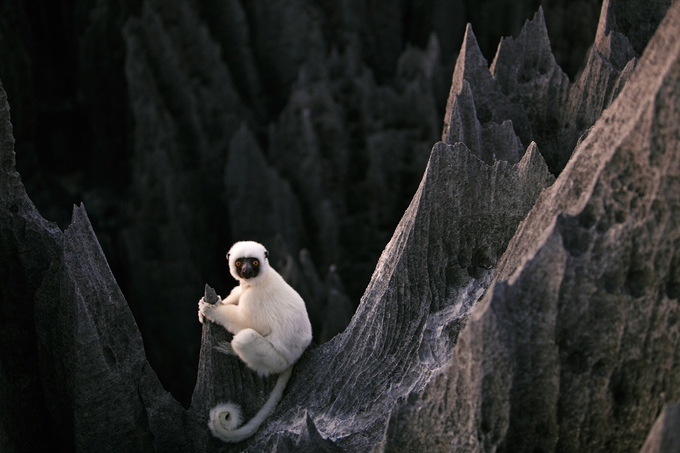10 journey to discover wildlife
The monarch butterfly kingdom in Mexico, humpback whales in Hawaii are impressive places to see wildlife by National Geographic magazine.

Lemurs, Madagasca
Madagascar island is home to more than 100 species of lemurs not found anywhere else on earth. Andasibe National Park is where visitors can see endemic lemurs. Lemurs have large eyes, long tails, and are diverse in size, from the largest Indri lemur in Madagascar (pictured) to Berthe rat lemur, the world's smallest primate, weighing only 30 grams. Photo: Stephen Alvarez.

Monarch butterfly, Mexico
Every year, millions of monarch butterflies (Danaus Plexippus) make the journey more than 4,800 km from Canada to wintering in pine forests in Mexico. Their most abundant habitat is at Monarch Butterfly Biosphere, which is located about 96 km northwest of Mexico City.
Monarch butterflies are the most famous butterfly in North America. The distinguishing feature to identify them is in striking orange, black and white wings, with a wingspan of about 8.9 - 10.2 cm. Visitors can explore the monarch butterfly kingdom in Mexico between January and February, when the butterflies gather in the largest concentration. Photo: Joel Sartore.

Humpback whales, Hawaii
Humpback whales in the summer live in southeastern Alaska and migrate to winter, breed in waters near the island of Maui, USA. The place to observe the whale is the area between Ma’alaea and Lahaina, near the Highway 30 highway on the island of Maui. On the photo is a mother weighing 30 tons will with 10 tons child perform "dance" to jump out of the water. Photo: David Fleetham.

Bat-tail bats, USA
At every sunset in the summer, millions of bats poke their tails out of the Carlsbad cave in New Mexico, USA. They fluttered in the sky, forming dark swirls. Tourists who love to explore nature can wait at the mouths of caves at the end of the afternoon to see this scene. Photo: Joel Sartore.

Porcupine reindeer, Canada
In early spring or autumn, visitors to Canada's remote Vuntut National Park will observe the migration of over 130,000 Porcupine reindeer. They journey nearly 2,500 km across the border of Alaska, USA to the coastal plains of Beaufort, Arctic to search for food and breed in the winter. Photo: DeSmog Blog.

Mountain gorilla, Uganda
Strictly protected Bwindi National Park, Uganda is home to more than 350 individuals of mountain gorillas out of the approximately 750 remaining in the wild. Visitors who want to see the animal need to register with the ranger station and follow their instructions along the way. The cost of the license will be lower in April, May and November. Photo: Michael Poliza.

Leatherback turtles, Trinidad
The coast of Trinidad Island is home to about 10,000 leather turtles (aka tortoises) during the spawning season. This is the largest sea turtle in the world, each adult female weighs over 900 kg, can dive as deep as 1,280 m. During the six-month breeding season, the turtles lay eggs dozens of times with about 8 eggs each. The eggs will hatch off after two months. Mother turtles and eggs are protected, so visitors should contact the management in Matura and Grande Rivière to apply for a license to observe turtles lay eggs. Photo: Thomas Peschak.

Salmon, Alaska
By the end of the summer, millions of salmon from the sea returned to the upstream where they were born, to lay eggs and die. One of the places to observe the spectacular migration of salmon is the Anan Wildlife Observatory, near the town of Wrangell, Alaska, USA. This is also the time when nearly 100 grizzly bears stand on the rocks to hunt for salmon. Visitors must contact the management in Anan for a permit from July to the end of August. Photo: Michael Melford.

Black seagulls, Falkland Islands
During the breeding season of the black-eyed albatross from September to November, visitors can see them parked on the cliffs of the Falkland Islands, the South Atlantic Ocean to nest. The island is home to more than 70% of the world's albatrosses. They can fly in the air for months, even years, without landing on land thanks to a wingspan of more than 2 meters and taking advantage of the wind. Black albatrosses can live up to 70 years and always go back to where they were born for nesting. Photo: Paul Nicklen.

Ancient albatross, Scotland
Ancient albatross has a large bill, stocky body, short tail and orange feet. Each year, the birds migrate to Scotland and concentrate on the rugged cliffs that stretch from northern Berwick to Handa Island off the coast of Sutherland with hundreds of thousands of birds. During April to August, visitors can choose the remote Foula island with high cliffs to see this bird. Photo: Frans Lanting.
FIDITOUR TRAVEL COMMUNICATION COMPANY
Representative: Mr. Tran Van Long - Chairman and General Director
Head office: 95B-97-99 Tran Hung Dao, District 1, City. Ho Chi Minh.
Hanoi Branch: 66 Tran Hung Dao, Hoan Kiem District, Hanoi
Phone: 028 730 56789 | Hotline: 19001177